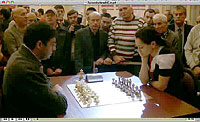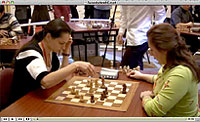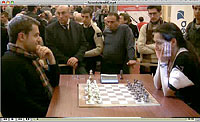Chess Puzzle: Are you thinking right?
Often in a chess match you reach a middle game where apparently nothing is to be done. Everything is in order and nothing you do could tilt the balance. There are no places to try tactics and the position is what you would call dull. It's in such situations that you have to learn to think right.
Look at the following puzzle and think about what you would do as White.
Position after 23. ... Rfd8
White should have the advantage because of his better Bishop though the Knight on b4 might be a problem. How would you proceed?
- Nb1 - The idea is to force the Black Knight to a bad square with c3 and later activate the White Knight via d2 and f3
- Rfd1 - The Black Knight can be tackled later and though you don't want to leave the f-file it is better to control the open d-file
- Re2 - The Black Knight is not a problem and d-file entry points are actually all covered. No point swapping pieces when you have a space advantage so hope to double on f-file later
- Bc5 - It is best to swap rooks and pieces because White would be left with a good Knight against a bad Bishop and possibly a passed a pawn. Then the endgame would be won.
- Na2 - All said and done one must first exchange bad pieces for good ones so it's better to force this Knight swap.
Take your time thinking about what should be best for White.
Well! good players always hate exchanging Bishops for Knights so some of these options don't work. Although there is a pawn on e5, the dark-squared White Bishop still has plenty of scope. Indeed, after, say, 24.Bc5 Qb7 25.Rxd8+ Rxd8 26. Bxb4 axb4 27. Ne2 Bg5 Black would have plenty of activity. Also, 26. ... Rd4 might be quite powerful.
This game is taken from Karpov-Spassky, Leningrad, 1974 and went as follows:
24. Nb1! Qb7 25. Kh2!
A precautionary move.
25. ... Kg7 26. c3 Na6 27. Re2
Preserving pieces
27. ... Rf8 28. Nd2 Bd8 29. Nf3 f6 30. Rd2 Be7 31. Qe6! Rad8 32. Rxd8 Bxd8 33. Rd1 Nb8 34. Bc5 Rh8

35. Rxd8 1-0 (in view of Be7)
From Alexandra Kosteniuk's
www.Chessblog.com
Also see my personal blog at
www.Chessqueen.com
Labels: Puzzle



































1 Comments:
At June 21, 2010 at 3:28 PM , Oreste said...
Oreste said...
Alexandra,thanks for the lesson.
Post a Comment
Note: Only a member of this blog may post a comment.
Subscribe to Post Comments [Atom]
<< Home